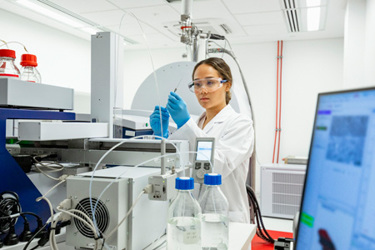Bioprocessing Illuminated: Harnessing The Magic Of Raman Spectroscopy

By John Oncea, Editor

Raman spectroscopy provides a powerful tool for molecular analysis, while bioprocessing plays a crucial role in the production of bioproducts. Let’s take a look at how the integration of these two fields contributes to advancements in various scientific and industrial applications.
So far this year we’ve looked at seven spectroscopy-related discoveries and four unique uses of Raman spectroscopy. Let’s shake things up a bit and zero in on a more specific story – the relationship between Raman spectroscopy and bioprocessing, two distinct but interconnected fields.
“Raman spectroscopy is,” according to the National Center for Biotechnology Information (NCBI), “an optical spectroscopy technique that provides a ‘molecular fingerprint’ of a sample. As an optical method, Raman enables nondestructive analysis of chemical composition and molecular structure.”
In the last thirty years, there has been a significant increase in the use of Raman spectroscopy in bioprocessing and biomedical analysis. This growth is due mainly to the improvements in laser sampling and detector technology. As a result, Raman spectroscopy has become a practical analysis technique both inside and outside the laboratory.
Raman spectroscopy is a well-established technology used in process analysis. Since the 1980s, it has been utilized to study active pharmaceutical ingredients (API). Raman spectroscopy has proven to be a versatile tool in API analysis, with applications including polymorph identification, quantitative analysis, real-time release testing, monitoring of in situ crystallization, process-induced transformations, and pharmaceutical unit operations.
“In addition to identifying isolated polymorphic forms, mixtures of forms can be analyzed and quantified,” writes NCBI. “The diverse structures that have been measured by Raman, from the discovery laboratory to the manufacturing environment, show that Raman can reliably provide quantitative data. In-line Raman spectroscopy can control critical process parameters, enables real-time process corrections, and ensures consistent production of the correct API form.”
These new applications in API synthesis and crystallization, real-time release testing, flow or continuous manufacturing, and other recent developments in Raman spectroscopy have helped provide a better understanding and control vis-a-vis bioprocesses.
For the sake of this article, let’s think of bioprocessing as the use of living cells, cell components, or biological systems to manufacture products. Bioprocessing is a term used in various sectors such as pharmaceuticals and biofuels. It encompasses the whole process from the beginning to the end. This includes the initial upstream steps that involve identifying components of interest and developing methods to cultivate them in laboratories. The term also includes downstream steps such as purifying components, as well as the manufacturing and packaging of finished products.
How Raman Spectroscopy Benefits Bioprocessing
Raman spectroscopy is a powerful analytical technique that can be employed in bioprocessing in several ways by offering real-time, non-destructive analysis of various parameters, ultimately contributing to the optimization and quality control of bioproduction processes.
For instance, it can be used to monitor the viability and metabolic activities of cells in bioprocessing. By analyzing the Raman spectra of cells, researchers can gain insights into cellular processes, such as nutrient uptake, waste production, and overall cell health.
Raman spectroscopy is also a valuable tool for tracking the formation of specific products in bioprocessing, such as proteins, antibodies, and other biomolecules, allowing for real-time monitoring of production processes. It also can monitor the consumption of substrates and the formation of byproducts during bioprocessing. This information is crucial for optimizing process conditions and improving yields.
When it comes to quality control, Raman spectroscopy can help identify and characterize biomolecules present in the bioprocess, ensuring the production of the desired product with the correct attributes. It also enables the detection of variations in the bioprocessing environment, allowing for rapid adjustments to maintain consistent product quality.
By providing real-time, in situ monitoring of bioprocesses without the need for sample extraction, Raman spectroscopy helps maintain sterile conditions and prevents contamination. It also can be used to assess the homogeneity of cell cultures within bioreactors. This is important for ensuring uniform growth and productivity throughout the bioprocessing vessel.
Finally, Raman spectroscopy can be employed to monitor pH and temperature within bioreactors, information that is critical for optimizing the growth conditions of the cells, as well as facilitating the transfer of bioprocessing protocols from small-scale to large-scale production by providing a non-invasive means of monitoring key parameters.
